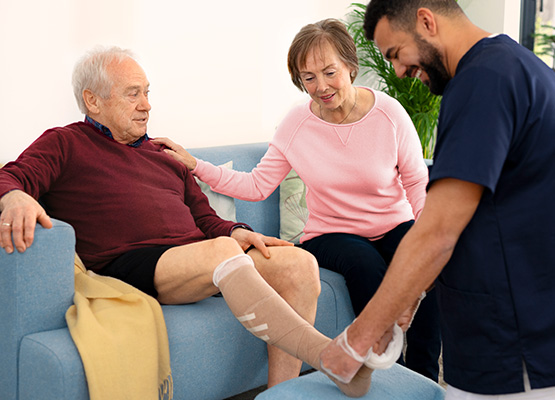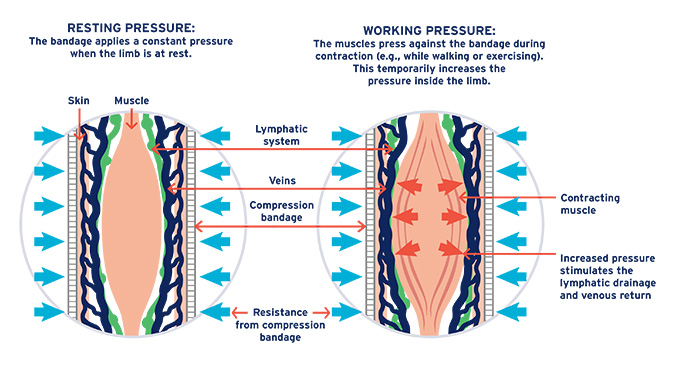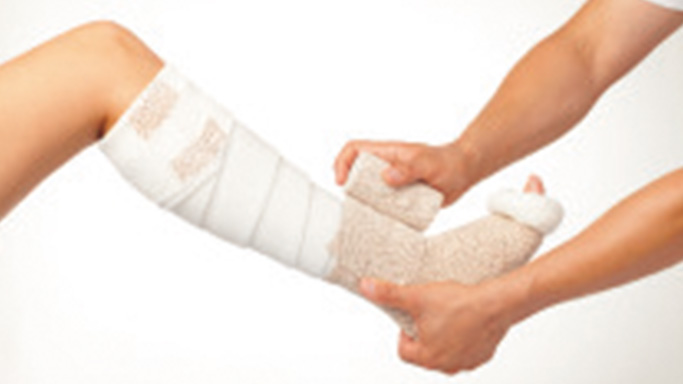

Compression bandages have the advantage of being adjustable. Their purpose is to reduce severe swelling before your limb can be measured for compression garments. They can be adjusted to changes in your limb size and shape as soon as the swelling decreases.
Compression bandages are normally used in the early stages of lymphedema treatment in the first phase of Complete Decongestive Therapy (CDT).
CDT is considered the gold standard of lymphedema treatment. It consists of two phases.
The first phase is Decongestion. This step lasts 2-4 weeks, reducing swelling and restoring both limb shape and skin condition. Manual Lymphatic Drainage is applied, along with compression bandages, skin care and exercise.
The second phase is Maintenance. Once the swelling has been reduced in the first phase, it is important to keep the swelling down through compression garments and self-management. Then, Manual Lymphatic Drainage, skin care and exercise are continued for holistic treatment.


There are two main categories of compression bandages: short-stretch and long-stretch. They differ in their ability to be stretched from their original length. This influences the pressure profile under movement or at rest. For lymphedema management, only short-stretch bandages are used.
Short-stretch bandages are compression bandages which do not stretch more than 100% of their original size. These bandages have a high stiffness and create a tight containment against which the muscles contract. A desired level of compression can be applied at rest, called resting pressure, whereas the pressure temporarily increases during movement (working pressure). This helps to transport the lymph fluid and the venous blood to the center of the body, thereby reducing edema. The principles of resting and working pressure are illustrated on the left. The bandager can vary the exerted pressure of a short-stretch bandage by using more or less strength during application. In general, the difference between resting and working pressure is greater for short-stretch than for long-stretch bandages.
Compression bandages can be combined with pads to either increase or evenly distribute the pressure on your affected limb. Pads can also improve comfort and are usually less likely to cause skin problems.
There are two types of bandaging systems that differ in the layers used for application.
is a compression system of several bandage layers. It is the standard approach for CDT. There are 4-5 components of MLLB:
are an alternative to MLLB. The two layers are:

Only experienced practitioners with appropriate training should apply compression bandages. Bandaging usually involves your affected limb and may also include the adjacent hand or foot. The bandages can be bulky but should still allow free movement of your limb. Depending on the severity of your lymphedema, the bandages are applied 2-4 times per week for 2-6 weeks. Once your swelling has reduced sufficiently, your limb can be measured for appropriate compression garments.
Care for your skin: Keeping your skin properly hydrated and crack-free is essential in preventing infections, such as cellulitis. Avoid taking hot showers and sufficiently moisturize with an appropriate product that should be well-absorbed before applying your bandages or garments.
Care for your bandages: Bandages require regular washing, not only for hygienic reasons but also to maintain their functionality. Choose a gentle wash cycle with a mild detergent, and don’t use a fabric softener or brightener. Using a laundry net can protect your garments from damage.